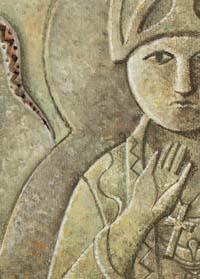|
Saints and Scholars

Irish history really begins with Saint Patrick, who converted Ireland to Christianity. The
son of a civil servant in Roman Britain, he was abducted and sold into slavery
in County Antrim. Escaping to the
European mainland, he eventually returned to Ireland as a missionary and
bishop. His first church was at Saul, in County Down, and he later made Armagh
the ecclesiastical capital of the island, as it has remained. Traditionally his
arrival in Ireland has been dated 432 AD, but some scholars believe it was much
later in the fifth century and that he completed the work begun by an earlier
missionary.
Whatever the truth of this, Christianity provided not merely a
religion but also a written language, Latin. A tradition of story-telling had
preserved accounts of great events, tribal histories and genealogies. Now there
were scholars who recorded this material on vellum manuscripts, no doubt
amending and embroidering it as they blended fact and legend. Such laborious
work was aided by the spread of monasteries, often on isolated islands or
mountains, where monks lived austerely and could pursue their studies free from
the demands placed on conventional priests.
Ireland, situated at the western edge of Europe, was certainly inhabited as early
as 6,000 BC. Archaeology provides evidence of successive invasions, hunters and
fishermen followed by fanners using stone tools to clear land, then by tribes
skilled in metalwork. The last pre-Christian invaders were the iron-using Celts
or Gaels, who reached Ireland around 600 BC. More than 1,000 years later, it
was a well-established pagan Celtic society which accepted Christianity.
|
Fifth-century Ireland was divided into a number of small kingdoms.
The more influential kings received tribute from the weaker ones, but the idea
of a high king of Ireland is a later invention. The Celts were cattle fanners,
wealthy enough to devote some resources to intricate gold and silver ornaments,
sophisticated enough to have lawyers (brehons) and poets (filidh)
as well as the druids who practised magic and offered sacrifices to the pagan
gods. They had their own language, from which modem Irish has evolved. Kings
were elected, but from a narrowly defined group possessing royal blood. Wars were common, and the balance of power
between kingdoms shifted constantly.
Saint Patrick divided Ireland into dioceses, but before long abbots
became more influential than bishops. The monasteries were important seats of
learning at a time when the European mainland was entering a dark age following
the collapse of the Roman Empire. In time Irish monks set out to spread the
Christian message in foreign countries. Among them were Saint Columba, who
founded a famous monastery on the Scottish island of lona, and Saint
Columbanus, who founded monasteries in France, Germany and Italy.
Ireland had escaped invasion by the Roman legions, but it could not
escape the Viking longboats which menaced its coasts and rivers in the ninth
century. But, while the Norsemen sacked monasteries, they also settled as
traders and founded settlements which grew into such cities as Dublin, Cork and
Limerick. The Celtic kingdoms
eventually fought back, and in 1014 Brian Boru, who had claimed the high
kingship, won a decisive victory over the Norsemen at Clontarf, near Dublin.

By now the Church was in disarray, the monasteries corrupt and the
dioceses ineffective. However, the establishment of Cistercian monasteries from
1142 on, and the reorganisation of the Irish Church at the Synod of Kelts in
1152 set reforms in motion. The petty kingdoms remained a source of disunion.
Brian Boru had been killed at Clontarf, and successive aspirants to the high
kingship were unable to enforce their authority. The land of saints and
scholars lacked military and political cohesion, and was in no condition to
repel the next invaders who sailed for Ireland.
|